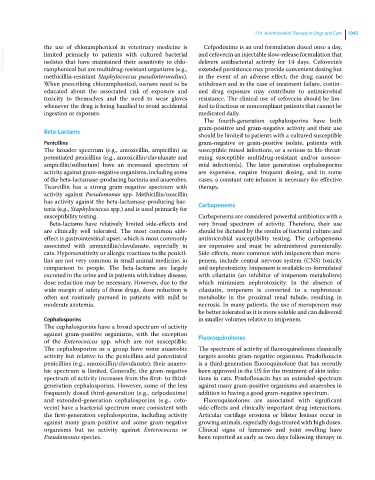Page 1107 - Clinical Small Animal Internal Medicine
P. 1107
114 Antimicrobial Therapy in Dogs and Cats 1045
the use of chloramphenicol in veterinary medicine is Cefpodoxime is an oral formulation dosed once a day,
VetBooks.ir limited primarily to patients with cultured bacterial and cefovecin an injectable slow‐release formulation that
delivers antibacterial activity for 14 days. Cefovecin’s
isolates that have maintained their sensitivity to chlo-
ramphenicol but are multidrug‐resistant organisms (e.g.,
in the event of an adverse effect, the drug cannot be
methicillin‐resistant Staphylococcus pseudintermedius). extended persistence may provide convenient dosing but
When prescribing chloramphenicol, owners need to be withdrawn and in the case of treatment failure, contin-
educated about the associated risk of exposure and ued drug exposure may contribute to antimicrobial
toxicity to themselves and the need to wear gloves resistance. The clinical use of cefovecin should be lim-
whenever the drug is being handled to avoid accidental ited to fractious or noncompliant patients that cannot be
ingestion or exposure. medicated daily.
The fourth‐generation cephalosporins have both
gram‐positive and gram‐negative activity and their use
Beta‐Lactams
should be limited to patients with a cultured susceptible
Penicillins gram‐negative or gram‐positive isolate, patients with
The broader spectrum (e.g., amoxicillin, ampicillin) or susceptible mixed infections, or a serious to life‐threat-
potentiated penicillins (e.g., amoxicillin/clavulanate and ening susceptible multidrug‐resistant and/or nosoco-
ampicillin/sulbactam) have an increased spectrum of mial infection(s). The later generation cephalosporins
activity against gram‐negative organisms, including some are expensive, require frequent dosing, and in some
of the beta‐lactamase‐producing bacteria and anaerobes. cases, a constant rate infusion is necessary for effective
Ticarcillin has a strong gram‐negative spectrum with therapy.
activity against Pseudomonas spp. Methicillin/oxacillin
has activity against the beta‐lactamase‐ producing bac- Carbapenems
teria (e.g., Staphylococcus spp.) and is used primarily for
susceptibility testing. Carbapenems are considered powerful antibiotics with a
Beta‐lactams have relatively limited side‐effects and very broad spectrum of activity. Therefore, their use
are clinically well tolerated. The most common side‐ should be dictated by the results of bacterial culture and
effect is gastrointestinal upset, which is most commonly antimicrobial susceptibility testing. The carbapenems
associated with amoxicillin/clavulanate, especially in are expensive and must be administered parenterally.
cats. Hypersensitivity or allergic reactions to the penicil- Side‐effects, more common with imipenem than mero-
lins are not very common in small animal medicine, in penem, include central nervous system (CNS) toxicity
comparison to people. The beta‐lactams are largely and nephrotoxicity. Imipenem is available co‐formulated
excreted in the urine and in patients with kidney disease, with cilastatin (an inhibitor of imipenem metabolism)
dose reduction may be necessary. However, due to the which minimizes nephrotoxicity. In the absence of
wide margin of safety of these drugs, dose reduction is cilastatin, imipenem is converted to a nephrotoxic
often not routinely pursued in patients with mild to metabolite in the proximal renal tubule, resulting in
moderate azotemia. necrosis. In many patients, the use of meropenem may
be better tolerated as it is more soluble and can delivered
Cephalosporins in smaller volumes relative to imipenem.
The cephalosporins have a broad spectrum of activity
against gram‐positive organisms, with the exception Fluoroquinolones
of the Enterococcus spp. which are not susceptible.
The cephalosporins as a group have some anaerobic The spectrum of activity of fluoroquinolones classically
activity but relative to the penicillins and potentiated targets aerobic gram‐negative organisms. Pradofloxacin
penicillins (e.g., amoxicillin/clavulanate), their anaero- is a third‐generation fluoroquinolone that has recently
bic spectrum is limited. Generally, the gram‐negative been approved in the US for the treatment of skin infec-
spectrum of activity increases from the first‐ to third‐ tions in cats. Pradofloxacin has an extended spectrum
generation cephalosporins. However, some of the less against many gram‐positive organisms and anaerobes in
frequently dosed third‐generation (e.g., cefpodoxime) addition to having a good gram‐negative spectrum.
and extended‐generation cephalosporins (e.g., cefo- Fluoroquinolones are associated with significant
vecin) have a bacterial spectrum more consistent with side‐effects and clinically important drug interactions.
the first‐generation cephalosporins, including activity Articular cartilage erosions or blister lesions occur in
against many gram‐positive and some gram‐negative growing animals, especially dogs treated with high doses.
organisms but no activity against Enterococcus or Clinical signs of lameness and joint swelling have
Pseudomonas species. been reported as early as two days following therapy in

